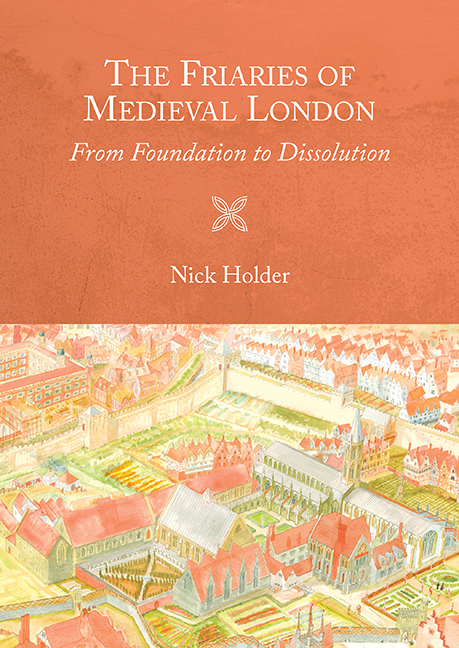Book contents
- Frontmatter
- Contents
- List of Illustrations and Tables
- Contributors
- Acknowledgements
- Abbreviations
- Introduction
- Part I The Nine London Friaries
- 1 The First Black Friars in Holborn, c. 1223–86
- 2 The Second Black Friars, 1275–1538
- 3 The Third Black Friars at St Bartholomew's, 1556–9
- 4 Grey Friars, 1225–1538
- 5 White Friars, c. 1247–1538
- 6 Austin Friars, c. 1265–1538
- 7 Crossed Friars, c. 1268–1538
- 8 Sack Friars, c. 1270–1305
- 9 Pied Friars, 1267–1317
- Part II The London Friars and their Friaries
- Conclusions
- Timeline
- Bibliography
- Index
- Miscellaneous Endmatter
6 - Austin Friars, c. 1265–1538
from Part I - The Nine London Friaries
Published online by Cambridge University Press: 16 May 2018
- Frontmatter
- Contents
- List of Illustrations and Tables
- Contributors
- Acknowledgements
- Abbreviations
- Introduction
- Part I The Nine London Friaries
- 1 The First Black Friars in Holborn, c. 1223–86
- 2 The Second Black Friars, 1275–1538
- 3 The Third Black Friars at St Bartholomew's, 1556–9
- 4 Grey Friars, 1225–1538
- 5 White Friars, c. 1247–1538
- 6 Austin Friars, c. 1265–1538
- 7 Crossed Friars, c. 1268–1538
- 8 Sack Friars, c. 1270–1305
- 9 Pied Friars, 1267–1317
- Part II The London Friars and their Friaries
- Conclusions
- Timeline
- Bibliography
- Index
- Miscellaneous Endmatter
Summary
IN the second quarter of the thirteenth century groups of Tuscan hermits were forming, a generation after St Francis’ band of poor itinerant preachers and St Dominic's group of anti-heretical preachers. Agreeing to follow the rule of St Augustine, the hermits came together and became a new mendicant order of friars in 1256, the Order of Augustinian Hermits. With this background, the interests and the inclinations of the brothers faced in different directions: the hermit tradition demanded isolation and favoured rural settings; the newer mendicant movement emphasised preaching and therefore lived more happily in towns. The hermits had reached England before their formal unification, probably establishing their first English house on the edge of the small Suffolk wool town of Clare by 1249. From this base the order spread to numerous English towns in the second half of the century, and the order and its houses became known as the Augustinian or Austin friars.
The Augustinian friars probably established their London house in the 1260s, slightly later than the date of 1253 given by the Tudor historian John Stow. Significantly, the Augustine friars – unlike the other mendicant orders – are not included in a list of recipients of royal alms given in Lent 1260. The first definite mention of this order of friars in London comes in 1271. Stow names Humphrey de Bohun, earl of Hereford and Essex, as the founder of the friary and de Bohun also made substantial gifts of land to other religious houses in England and Wales. Perhaps he founded the London house in or soon after 1265 when he was the royalist keeper of the city of London, guarding against a potential attack by Simon de Montfort (another friary founder!) and the barons.
The friary housed about sixty friars by the end of the thirteenth century. Although fluctuating and temporarily declining as a result of the Black Death, the numbers were broadly maintained throughout the fourteenth century but then fell in the fifteenth century. The friary was probably reasonably financially stable, having a rental income of nearly £60 by the sixteenth century, and receiving good support in the bequests given by Londoners in their wills.
- Type
- Chapter
- Information
- The Friaries of Medieval LondonFrom Foundation to Dissolution, pp. 119 - 141Publisher: Boydell & BrewerPrint publication year: 2017



